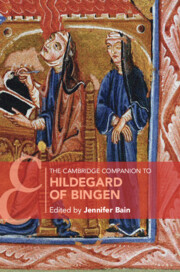Nathaniel M. Campbell, “Picturing Hildegard of Bingen’s Sight: Illuminating Her Visions.” Ch. 12 in The Cambridge Companion to Hildegard of Bingen, ed. Jennifer Bain. Cambridge University Press, 2021, pp. 257-279; access online here.
This chapter explores the development and purpose of the illustrations in two manuscripts of Hildegard of Bingen’s works: one designed by Hildegard (the Rupertsberg Scivias), the other designed by a later generation of her monastery’s nuns (the Lucca Liber divinorum operum). An overview of her visionary experiences demonstrates the prophetic mission of their detailed images to communicate theological truths. I argue that Hildegard designed the Scivias images to aid that communication and provide visual exegesis of her visions, serving as a teaching tool to guide the reader through the manuscript. The next generation of nuns followed Hildegard’s impulse to illustrate her visions with the later Liber divinorum operum manuscript, but its famous cosmological diagram diverges from the text because the designer did not understand its meaning. The chapter closes with an assessment of the very limited influence of Hildegard’s illustrations in the later Middle Ages, with one story from the preaching of Johannes Tauler demonstrating their liability to reinterpretation.


No comments:
Post a Comment